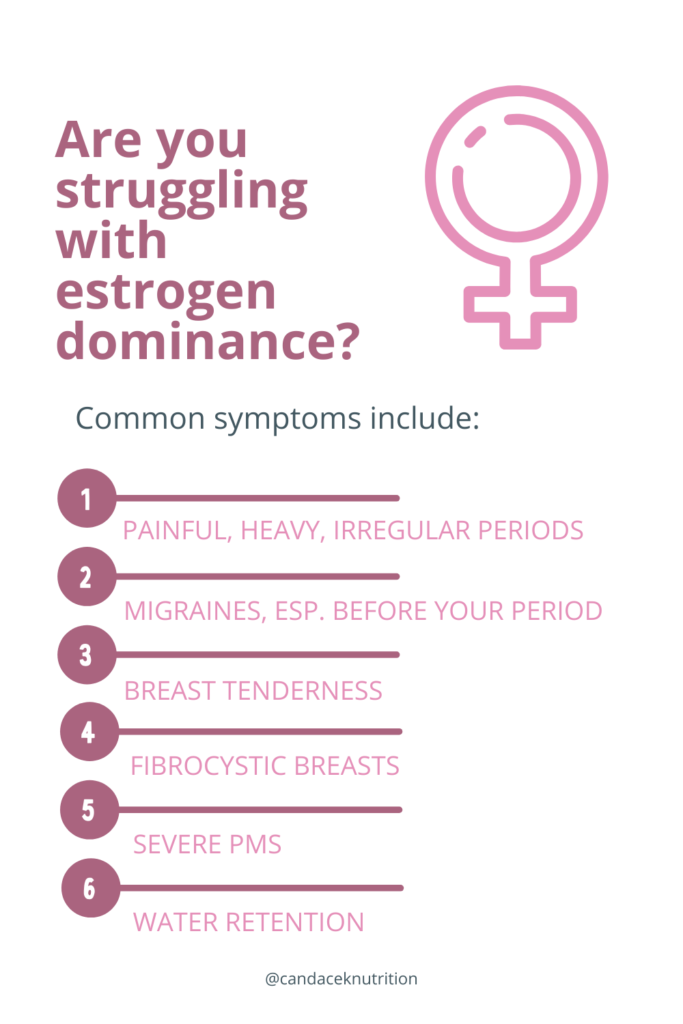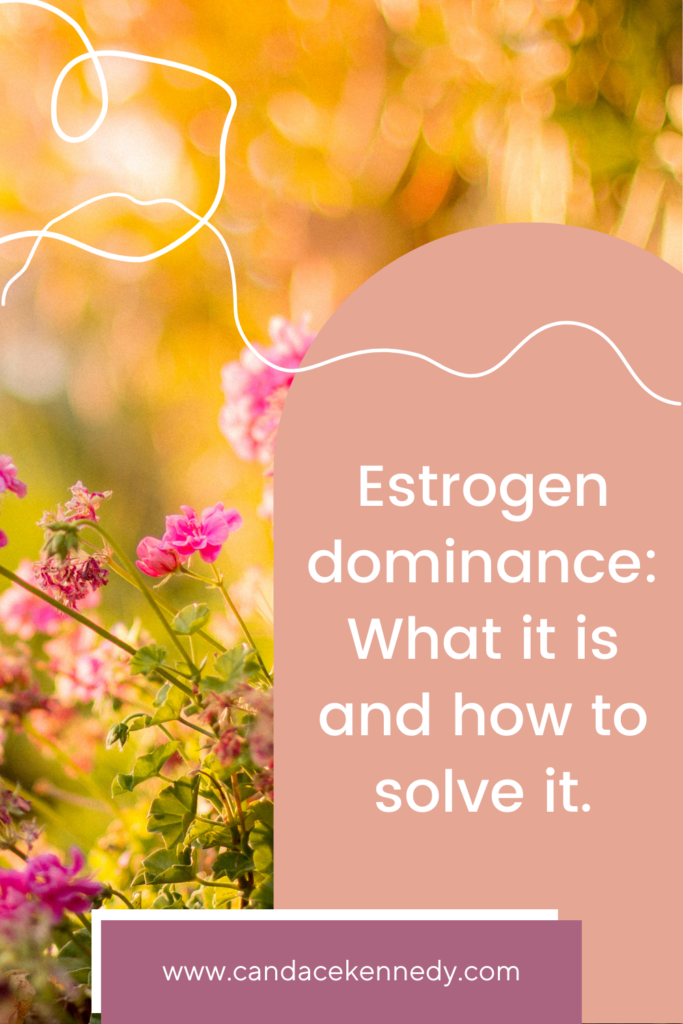Estrogen dominance is a common hormonal imbalance affecting many women. Thankfully, estrogen dominance is correctable with the right lifestyle and nutrition changes. This post will cover what estrogen is, how it gets out of balance and leads to estrogen dominance, and what you can do to bring your hormones back into balance.
What is estrogen?
Estrogen actually is a group of hormones. Estrogens are responsible for triggering secondary sex characteristics development like hips, breasts, and pubic hair. Throughout adulthood, estrogens regulate your reproductive system and play an important role in your menstrual cycle.
Estrogen is often described as “the female hormone” but men have estrogen too. They just have less of it.
There are three main types of estrogen:
- Estrone (E1). After menopause, your body only makes estrone, as it stops making the other two kinds.
- Estradiol (E2). Between menstruation and menopause, this is the dominant type of estrogen in women.
- Estriol (E3). Estriol increases during pregnancy.
Throughout your menstrual cycle, estrogen levels rise and fall. Estrogen is at its lowest on day 1 of your cycle, when menstruation begins. It rises during the first half of your cycle, the follicular phase, as it plays a role in preparing the body to release an egg at ovulation. Estrogen will then peak just before ovulation and drop during the second half of your cycle, the luteal phase.
Estrogen is not bad. But you can have too much of a good thing.
It’s important to highlight here that estrogen is not bad.
You need estrogen to:
➡️ Shape monthly hormonal cycle
➡️ Develop female body and characteristics
➡️ Prepare the uterus for pregnancy
➡️ Maintain healthy blood sugar levels
➡️ Control cholesterol levels
➡️ Produce melatonin, a sleep hormone
➡️ Maintain bone, skin, and hair health
But all things need to be in balance. Excess estrogen can cause a lot of problems. So can too little progesterone. They need to be in balance. You could have normal levels of estrogen, but if progesterone is too low, this is also considered estrogen dominance.
For those reasons, estrogen dominance can happen in two different ways:
- Your body is making too much estrogen. This is Frank Estrogen Dominance.
- Your estrogen is too high relative to your progesterone. This is Relative Estrogen Dominance.
An important reminder. Just because something is common, doesn’t mean that’s what it *should* be like. PMS, severely painful periods, etc. are all really common these days. But that doesn’t mean those symptoms are okay. These are symptoms you shouldn’t ignore.
Common Symptoms of Estrogen Dominance
Symptoms can vary from woman-to-woman and some women may only have one or two symptoms.
How do you know if you’re estrogen dominant? Common symptoms include:
- Painful periods
- Irregular/heavy periods
- Water retention
- Breast tenderness
- Migraines (especially before your period)
- Fibrocystic breasts
- PMS symptoms are often related to excess estrogen
- Precocious puberty in young girls
If excess estrogen goes unchecked for too long, it can lead to more serious health complications, including:
- Hypothyroidism
- Endometriosis
- Endometrial hyperplasia
- Breast, ovarian, and endometrial cancers
What causes estrogen dominance?
Hormones naturally fluctuate throughout our monthly cycles, with estrogen being higher in the first half (the follicular phase) and lower in the luteal phase. This is normal and not a hormonal “imbalance.”
However, modern life creates the perfect storm for our bodies to have abnormally elevated estrogen levels.
So how do things get out of balance? Some leading causes of estrogen dominance:
❗️Estrogen-mimickers in food/environment
❗️Slow digestion/elimination of estrogens (gut dysbiosis)
❗️Poor liver function
❗️Obesity
❗️MTHFR mutation that makes it harder to break down estrogens
❗️Birth control
How to Solve Estrogen Dominance
Stress and your environment have huge impacts on your hormones. While estrogen is important, it needs to be in balance with your other hormones.
If you are experiencing symptoms of estrogen dominance, the DUTCH test is a great tool for getting a clear idea of your hormone levels and fluctuations.
In the meantime, there are many steps you can take to start bringing your hormones back into balance.
1. PRIORITIZE SLEEP
Healthy hormones demand sleep. Kick up your sleep hygiene habits by making sure to sleep in a cold, dark room (no blue light), go to bed at the same time every night, and no screens for at least 90 mins before bedtime. Blue light-blocking glasses can help (Code CKN15 for 15% off).
And definitely get that morning sun! Morning sun in your eyes can help with the production and secretion of melatonin, your sleep hormone.
2. REDUCE STRESS
Stress increases cortisol at the expense of progesterone. Too much estrogen in relation to progesterone is also estrogen dominance, even if your estrogen levels are “normal.” Reducing stress is key to optimal hormones.
Breathwork, walking, meditation, yoga, dancing, art, baths. Adrenal support with adequate minerals and adaptogenic herbs can also be helpful.
3. REDUCE EXPOSURE TO XENOESTROGENS
Start reducing your exposure to xenoestrogens from plastics and harmful chemicals, switch your personal care products to ones free of harmful chemicals, filter your water, eat organic or pesticide-free produce, avoid conventionally farmed meat.
Beauty and personal care products are notorious for containing massive amounts of hormone-disrupting chemicals. Use beauty and personal care products from companies that are committed to non-toxic ingredients.
Some of my favorite clean beauty companies are:
- Kossma Beauty (Code CKN10 for 10% off)
- Beauty Care Naturals (Code CKN10 for 10% off)
- Primally Pure (great option for deodorant)
4. GET THE RIGHT NUTRIENTS
Being fully nourished and getting all the nutrients your body needs to make proper amounts of hormones is a foundation of healthy hormone balance. Beets, raw carrots, mushrooms, grass-fed protein, cooked broccoli/cauliflower, dark chocolate, dandelion root, milk thistle, avocado, blackberries are all supportive of a healthy hormone balance.
The raw carrot salad is also a great way to help bind up excess estrogen and endotoxin in the gut and remove it from your body.
5. ASSESS YOUR GUT HEALTH
If your gut bugs are out of balance and/or making too much beta-glucuronidase, you can end up with estrogen dominance. If you are often constipated, you are not clearing estrogen from your body effectively and it can be reabsorbed.
Work with a qualified nutritionist/practitioner if you’re interested in gut testing. With my clients, I often use GI Maps and SIBO testing. Strategic testing can help get to the root cause of estrogen dominance and gut issues.
A quality probiotic like Mitolife’s Probiotic and Endotoxin Reducer can also be very supportive. (Use code CKN15 for 15% off)
6. SUPPORT YOUR LIVER
Your liver is responsible for preparing estrogen to be removed from the body. It needs protein and b-vitamins from bioavailable meats, fish, poultry/eggs, and bone broth. Cooked cruciferous vegetables, garlic, onions are all liver supportive (so long as they don’t cause your gut distress.). Beets, dandelion, milk thistle, and castor oil packs can all be very supportive too.
Organic Olivia has a great liver-supportive tincture called Liver Juice with lots of great herbs and beets for liver health.
Finding Hormone Balance
As women, our intricate dance of hormones on a monthly cycle can give us so much insight into our overall health. While estrogen can often get mislabeled as “bad,” what really matters is the balance of our hormones and whether they are fluctuating in the right amounts at the right times of our cycles.
Experiencing estrogen dominance and its related symptoms can feel miserable and overwhelming at times, but it is entirely possible to correct it. Start with the six steps above and go from there.
Working with a nutritionist can help you get to the bottom of estrogen dominance.
Send me your questions and let me know what you’d like for me to cover in the comments below.
Important notes:
I am not a doctor, and I don’t claim to be one. I can’t prevent, treat, cure or diagnose illness or disease. The information presented on this website is not meant to replace a one-on-one relationship with a qualified health care professional and is not intended as medical advice, treatment or diagnosis. The purpose of this website is to share knowledge from my research and experience. I encourage you to make your own decisions regarding your health care based on your own research and relationship with your health care professional.
Some of the links on this page are affiliate links, which means I earn a small commission if you purchase through that link, at no additional cost to you. Thank you for supporting my work!




Trackbacks/Pingbacks